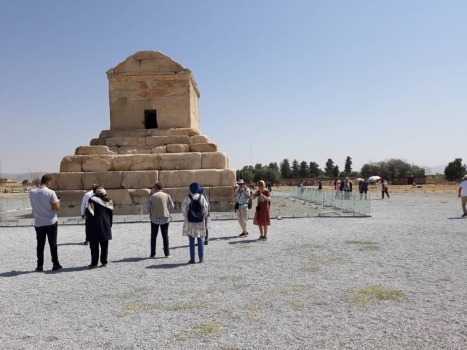Pasargadae
Pasargadae located 136 km away in the northeast of Shiraz; is the first capital of the Achaemenes Empire in Cyrus the Great between 559-530 BC. Pasargadae was created and constructed by the order of Cyrus the Great who founded the Achaemenid Empire in Pars. Pasargadae is an enormous masterpiece and unrivalled architecture of Iran destinations. Achaemenid was a vast Empire extended from the eastern Mediterranean and Egypt to the Hindus River in India. Pasargadae remained as capital till Cambyses II moved that to Susa. Pasargadae is a vast city in 160-ha including the tomb of Cyrus the Great, audience hall, palaces, Tall-e Takht and beautiful gardens which all are fine

examples of architectural masterpieces and Persian civilization in Achaemenid dynasty; the first multicultural Empire in the world that respected different cultures of its own people. Undoubtedly, it is a must to visit Pasargadae in your travel to Iran for knowing culture of people and civilization of Great Persia.
Topography of Pasargadae
Pasargadae is a rectangular plain in the north west of Fars province which is 136 Km far from Shiraz and the altitude of 1900 m above the sea level in the middle of Zagros mountains. It is irrigated by Plovar river so its land has been always fertile. Cyrus the Great established this city in the south west of the plain which constitutes of some buildings in the middle of no fenced gardens.
History of Pasargadae
Pasargadae is similar to Greek palaces in terms of architecture and design. It is probably because Cyrus captured Sardis the capital of Lydia in 545 BC and he was influenced by marble palaces of Lydian kings. Perhaps he employed many architects to build Pasargadae. The combination of black and white marble stones is remarkable. These stones have been brought from the city of Sivand in Marvdasht.
According to the archaeological researches, Pasargadae belongs to middle Paleolithic period but the name of Pasargadae was raised for the first time in Achaemenid dynasty.
Attractions of Pasargadae
There are eight sightseeing remained in Pasargadae which the most important monument is the mausoleum of Cyrus the Great and it is said the remains of the tomb of Cyrus’ son and successor Cambyses II has been found in Pasargadae as well. The other remained attractions are the Gate Palace with inscription of winged human, Audience Palace known as Bar Palace with high columns, the Private Palace, Stone Tower or Prison of Solomon, the stone sites in sacred zone, Darius’ Throne.
Zino Expedition designed many cultural tours of Iran including a visit of Pasargadae through Iran Classic route. You can find related tours in cultural tours.
Tomb of Cyrus the Great has been made of yellowish white limestone consisting of a platform, 6 stairs and a small room with sloping roof on top of the 6th stair. The area of this tomb is 156 sqm and 11 m height. The dimension of the room is 3.5 m length and 2.1m height with a stone door in 1.3×1 m.
The Gate Palace is located in the north east of the tomb of Cyrus the Great at a distance of 1250 m away. It has an area of 726 square meters. There is a lithograph of a winged man carved on the wall of north gate which is considered to be the statue of Cyrus. This lithograph is one of the oldest inscriptions of Achaemenid demonstrating a human with 4 wings dressed in an Elamite cloth praying towards the sky. There are 2 horns designed with three conical flowers on top of his crown resemble a carved crown. Pierre Briant the French archaeologist believes this lithograph is a winged angel.
Audience palace has been located in the north east of the tomb of Cyrus. The total area of this palace and the around rooms is 2464 m. The remains of an inscription demonstrate a worrier in a short jacket, a demon like a lion, a man who is a half-man and half-cow and a creature dressed in fish scales. It contained four halls which the east and west halls were at the same size with 16 columns. The capitals of the south hall were designed by the motifs of animals like lion, cow and flowers and the north hall faced to the garden and stone fountains. There are two pillars on two sides of eastern door which have a picture like Aa or Aha the Babylonian god of water and sea.
The Private Palace is 3410 square meters and 1350 m far from the tomb of Cyrus. Nothing has been left from this palace except some pieces of inscriptions and some words in cuneiform which is not much.
Prison of Solomon is a stone tower with a distance of 500 m in the north side of the Private Palace and only a wall of that has remained. This structure contained a square tower with three rows of false windows in 3 sides of that and a room with no window on the top.
The stone sites in sacred zone are located 1 km away from the Private Palace in the north west side. It has two hallow white stone sites with more than 2 meters’ height and 9 meters’ distance away from each other.
Darius’s Throne also known as Solomon’s mother’s throne built by order of Cyrus the Great on top of a hillock to hold the city, temples and palaces but it was abandoned after the death of Cyrus the Great in 530 BC. It is also called Tall-e Takht fort.
Zino Expedition designed many cultural tours of Iran including a visit of Pasargadae through the Iran Classic route. You can find related tours in cultural tours.
